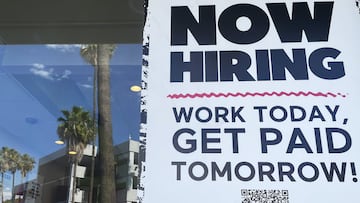Unemployment benefits: Have the additional $300 Covid-19 payments led to a labor shortage?
As more than half of states move to end federal pandemic unemployment benefits, the debate over if they cause labor shortages, has many in the US curious.

Leaders, economists, and business leaders from across the country have begun an opposition campaign to federal pandemic unemployment benefits, including the $300 a week sent in addition to state payments. These policymakers believe that these benefits discourage those who lost their jobs from beginning their reentry into the workforce.
This theory has led over half of the states to end these additional payments hoping that more people may begin to search for a new job.
The argument in favor: federal benefits are creating a labor shortage
Read more
There are millions of jobs available in the US, many in dining and brick and mortar retail, which were hit hard by the pandemic. A new study by the National Bureau of Economic Research found that almost seventy percent of those claiming benefits are making more through unemployment insurance than their previous job.
The average weekly benefit nationally, sent by states to those on unemployment since the beginning of 2021, stands around $317. When adding the $300 topper sent by the federal government, the weekly total is around $617, or around $15.40 an hour. This happens to be the rate many labor advocates argue should be the federal minimum wage to ensure that all those who work a full-time job do not live in poverty.
For workers who made the federal minimum wage or slightly above the $7.25 threshold, a weekly check of $300 basically accounts for their take-home pay. However, according to the Bureau of Labor Statistics, only a little over half a million workers in the US made minimum wage in 2019.
Incomes are pushed above their employment levels by the combined federal payments and state benefits, which in May ranged from $175 in Louisiana to $510 in Massachusetts. Meaning that the average unemployed worker in Louisiana makes around $475 a week, or about $11.80 an hour. Most economists think of people as rational, and if those without work see that they can make the same or more at home, the rational choice would be to continue claiming benefits.
Are the policies working?
While it is still early to evaluate whether the cutting of these benefits has moved more people into the workforce faster than states who have not, some data on job searches provide insights. Indeed, the online job search platform has released state-level job search data since the announcement to end benefits was made.
So far, job searches in those areas are not up. CNBC reported that for states that ended benefits on 12 and 19 June, job search rates are down four and one percent, respectively. For Indeed economist AnnElizabeth Konkel, this means that “people in those states are less likely to be searching than your average jobseeker right now.”
The assumption of those who believe the additional federal benefits is creating a labor shortage is that when cutting the payments, those who rely on them are forced to get looking for their next gig. This is one data point that shows this logic may not prove true. One career site can't track all job search movements within the labor market, but it may indicate that the June jobs numbers will not show major improvements in these states. The national unemployment numbers for June will be released late this week, while the state-specific rates will not be available until late July.
The argument against federal benefits are not creating a labor shortage
Representatives from the White House’s Council of Economic Advisers have stated that they have seen no evidence that these increased benefits contribute to labor shortages. This group is not alone.
For more progressive economist John Stegaliz, famous for his work examining global inequality, "a tight labor market is just what the doctor ordered." For Stegaliz, a "tight" market refers to one in which "demand for labor is strong," a situation that usually helps to increase wages for those at the bottom.
Combating claims that "excessively generous unemployment insurance benefits" are creating a labor shortage, the economist highlights "econometric studies comparing labor supply across US states," which "suggest that these kinds of labor-disincentive effects are limited." The Nobel prize-winning economist also agrees with the White House that the temporary nature of the benefits makes it unlikely to contribute to a labor shortage in a significant way. Rather, Dr. Stegaliz has focused his attention on how the "global economic effects of the virus will linger" beyond the life of the enhanced benefits, which in the long run could harm the economic recovery.
Additionally, models published in the Federal Reserve's 2021 Summary of Economic Projections, which combines the projections of top economists, found that by March 2023, the national unemployment rate would be around 3.5% -- roughly where it was before the pandemic.
In comments made in late April, Chairmen Jerome Powell stated that he assumes it may take a few months to reach the "equilibrium between labor supply and labor demand." Shortly after his remarks, the April jobs report was released, which showed that a quarter of the jobs projected were added to the economy.
After these numbers were released, many states moved to end federal benefits, hoping that it would increase the speed at which the equilibrium could be reached. In May, more than half a million jobs were added. But, of the ten states that had positive “statistically significant employment changes from April 2021 to May 2021,” only three were in states that were ending benefits. Additionally, when looking at the rates of civilian labor force participation from April to May, in states where the benefits are ending, participation fell .02%. Whereas in states where the federal payments will continue, the rate increased by 1.2%.






